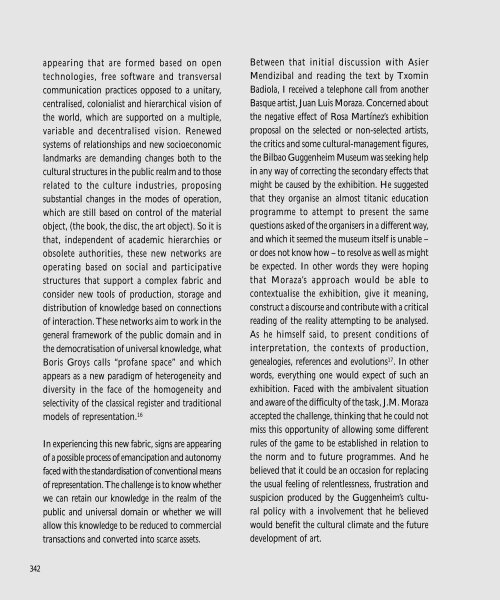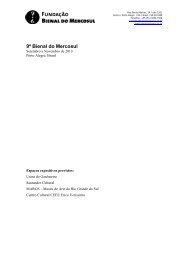Arte e Educação - Fundação Bienal do Mercosul
Arte e Educação - Fundação Bienal do Mercosul
Arte e Educação - Fundação Bienal do Mercosul
You also want an ePaper? Increase the reach of your titles
YUMPU automatically turns print PDFs into web optimized ePapers that Google loves.
342<br />
appearing that are formed based on open<br />
technologies, free software and transversal<br />
communication practices opposed to a unitary,<br />
centralised, colonialist and hierarchical vision of<br />
the world, which are supported on a multiple,<br />
variable and decentralised vision. Renewed<br />
systems of relationships and new socioeconomic<br />
landmarks are demanding changes both to the<br />
cultural structures in the public realm and to those<br />
related to the culture industries, proposing<br />
substantial changes in the modes of operation,<br />
which are still based on control of the material<br />
object, (the book, the disc, the art object). So it is<br />
that, independent of academic hierarchies or<br />
obsolete authorities, these new networks are<br />
operating based on social and participative<br />
structures that support a complex fabric and<br />
consider new tools of production, storage and<br />
distribution of knowledge based on connections<br />
of interaction. These networks aim to work in the<br />
general framework of the public <strong>do</strong>main and in<br />
the democratisation of universal knowledge, what<br />
Boris Groys calls “profane space” and which<br />
appears as a new paradigm of heterogeneity and<br />
diversity in the face of the homogeneity and<br />
selectivity of the classical register and traditional<br />
models of representation. 16<br />
In experiencing this new fabric, signs are appearing<br />
of a possible process of emancipation and autonomy<br />
faced with the standardisation of conventional means<br />
of representation. The challenge is to know whether<br />
we can retain our knowledge in the realm of the<br />
public and universal <strong>do</strong>main or whether we will<br />
allow this knowledge to be reduced to commercial<br />
transactions and converted into scarce assets.<br />
Between that initial discussion with Asier<br />
Mendizibal and reading the text by Txomin<br />
Badiola, I received a telephone call from another<br />
Basque artist, Juan Luis Moraza. Concerned about<br />
the negative effect of Rosa Martínez’s exhibition<br />
proposal on the selected or non-selected artists,<br />
the critics and some cultural-management figures,<br />
the Bilbao Guggenheim Museum was seeking help<br />
in any way of correcting the secondary effects that<br />
might be caused by the exhibition. He suggested<br />
that they organise an almost titanic education<br />
programme to attempt to present the same<br />
questions asked of the organisers in a different way,<br />
and which it seemed the museum itself is unable –<br />
or <strong>do</strong>es not know how – to resolve as well as might<br />
be expected. In other words they were hoping<br />
that Moraza’s approach would be able to<br />
contextualise the exhibition, give it meaning,<br />
construct a discourse and contribute with a critical<br />
reading of the reality attempting to be analysed.<br />
As he himself said, to present conditions of<br />
interpretation, the contexts of production,<br />
genealogies, references and evolutions 17 . In other<br />
words, everything one would expect of such an<br />
exhibition. Faced with the ambivalent situation<br />
and aware of the difficulty of the task, J.M. Moraza<br />
accepted the challenge, thinking that he could not<br />
miss this opportunity of allowing some different<br />
rules of the game to be established in relation to<br />
the norm and to future programmes. And he<br />
believed that it could be an occasion for replacing<br />
the usual feeling of relentlessness, frustration and<br />
suspicion produced by the Guggenheim’s cultural<br />
policy with a involvement that he believed<br />
would benefit the cultural climate and the future<br />
development of art.




